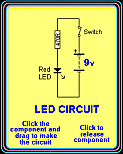BASIC
ELECTRONICS COURSE
Page 1
![]()
| This course is an entirely new way to learn electronics. It has many features such as animations and activities that only a computer-presentation can provide. In addition, the format consists of questions and answers. Sometimes the questions are asked before the theory is provided. This is the way it happens in the real world. It is called Reverse Learning and has proven to be a much faster way to learn. There are many other features, so . . . . |
|
Before we start, there has been a lot of websites that try to explain VOLTS,
AMPS and OHMs. We use CONVENTIONAL CURRENT that flows out the positive
terminal of a battery and into the negative. Don't worry about water flowing through a pipe or putting your foot on a hose or filling a bucket. All these comparisons don't help. The only thing to remember is OHM's Law and it is the VOLTAGE that pushes CURRENT through a circuit and the amount of current is determined by Ohm's Law. When you have components, such as LEDs and diodes that have a natural voltage drop across them, you take this voltage from the supply voltage and then use Ohm's LAW. |
. . . let's start. Click your mouse on the switch:
Question 1: What happens when the
switch is closed? Question 2: The switch completes the
circuit. What does this mean?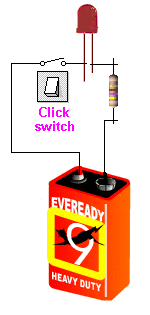
Ans: The LED
illuminates.
Ans: The current (we say "the
current" meaning "electricity") flows out the positive terminal of the battery, through the switch, through the LED, through the
current limiting resistor and into the negative terminal of the battery
The
schematic diagram (the diagram made up of symbols) does not have to look like
the layout diagram. The components may not appear in exactly the same places
but
the end-result is the same and both work the same. A
schematic diagram generally has a defined way the components are laid out. This
makes it easy for the reader to understand how the circuit works. Question 3: What
do the letters
The schematic diagram
above consists of 4 symbols (a resistor,
a LED,
a switch
and a battery) with lines or wires to connect the components together. Here
are the 4 symbols:




There are over 100 electronic symbols in our
Library of Symbols
Ans: Light Emitting Diode.
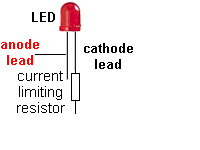
The length of the leads of a component (symbol) on a circuit diagram does not indicate the actual length of the leads. In reality the cathode lead of a LED is the shorter of the two. If you cut both leads the same length, you have to refer to the small flat spot on the side of the LED to identify the cathode lead. (Or connect the LED to a battery via a resistor!)
Question 4: A Light Emitting Diode has
two leads, name them.
Ans: Anode and cathode.
Question 5. How do you identify the
cathode lead on an LED?
Ans: It is the shorter lead.
A flat
on the side of the LED also indicates the
cathode lead.
Question 6: How do you connect a LED to
a supply voltage?
Ans: The anode is connected to the
positive of the supply and the cathode is connected to the negative via a CURRENT LIMITING RESISTOR.
Question 7: Why do you need a current
limiting resistor?
Ans: The current
limiting resistor prevents too
much current flowing through the LED and damaging it.
Question 8. Can the current limiting
resistor be
put on the anode lead?
Ans: Yes. It doesn't matter which lead
has the current limiting resistor, providing it is always included.
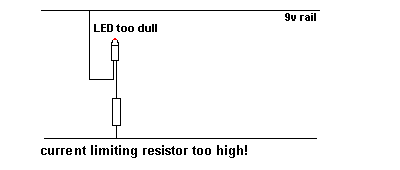
Question 9: What does the negative rail
mean?
Ans: It means the negative of the
battery is connected to this rail.
It can also be referred to as 0v or earth. These all mean the negative rail.
Question 10. Why is the current
limiting resistor needed?
Ans: A LED is not a globe. It has no
filament and it does not get hot.
It is an electronic device and is nothing like a globe at all. The only
similarity is they both give off light. Light from a LED is produced by current flowing through a crystal structure and if
too much current flows, the crystal will be damaged.
Question 11. How much current does a
LED need to produce light?
Ans: It requires about 25mA
to produce a very good glow. A LED will start to glow at 1mA and get brighter as
the current increases.
Question 12. What colours are produced
by LEDs?
Ans: A LED does not give off white
light. It gives off coloured light. The most common colours are: Red, green,
Question 13. How can you make a LED
give off while light?
Ans: If a red, green and blue LED are
combined together and connected to a supply, the combined light output from the three LEDs will appear as a
source of white light.
Question 14. If you connect a LED
around the wrong way, will it work?
Ans: No. It will not illuminate.
It may not be damaged but it will NOT work.
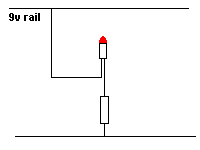
Question 15. What will happen if you
connect a LED to the supply rail without a current limiting resistor.
Ans: A very large current will flow
through the LED and it will be instantly
damaged. This is one of the major differences between a globe and a LED.
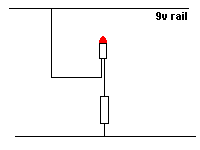
THE
FLASHING LED
The Flashing LED is not a normal LED.
It has a light emitting semiconductor inside the body and it also
contains a microchip flasher circuit and a current limiting resistor so the LED
can be connected directly to a 5v to 9v supply. It flashes about once per
second. This is not the type of LED we are talking about in this discussion. The
animation below shows a flashing LED connected directly to a 9v battery. Don't
confuse the two. The only way to tell them apart is to connect each to a
9v battery WITH A CURRENT LIMITING RESISTOR. If one LED flashes, you can remove the
resistor and it will flash. The other does not flash and is the type we are talking
about in this discussion.
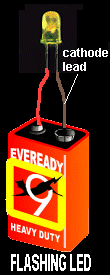
is needed for a flashing LED
Now, back to the questions:
Question 16. How do you get the correct
brightness from a LED?
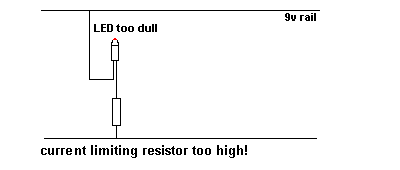
Question 17: How does the value of the
dropper resistor control the light
output from a LED?
A dropper resistor is like a narrow part in a hose - like standing on a hose.
If you stand on a hose you increase the "resistance to the flow of water."
A high value resistor reduces the flow of electricity and the LED is dull. A low value of resistance allows a high current to flow - just like removing your foot from the hose and the LED increases in brightness. A piece of wire has a low resistance and special carbon compounds have a high resistance. A resistor is made from carbon compounds and if is has a very low resistance it is said to have LOW OHMS.
Question 18. What are the values of
resistance for a resistor?
![]()
In th
e subscription section we have pages to show you more about the resistor and a COLOUR CODE calculator for resistors. It covers the standard values for resistors.![]()
Question 19. How does a resistor
in a circuit compare to water flowing through
a pipe?
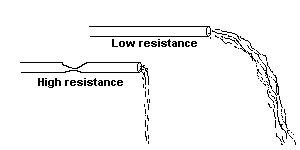
Question 20: A LED is not like a globe,
it doesn't get hot, it doesn't give off white light, and it doesn't require very much current. Are there an other
characteristics?
Some of the early LEDs produced less than 50millicandellas for 25mA current flow. Super high-bright LEDs can emit 1,000, 2,000 and even 3,000millicandellas for 25mA current flow.
Question 21: What is
1,000millicandellas?
Question 22: What is the
"characteristic voltage" for a red LED?
We can now work out the value of the current limiting resistor (in ohms) because the equation linking the voltage of the supply rail, the current flowing in the circuit and resistance of the dropper resistor is called OHMS LAW.
Question 23: What is Ohms Law?
When you subscribe, we have a calculator that will work out any value in an Ohm's Law equation.

Question 24: We know the voltage
of the supply is 9v (we are using a 9v
battery) and the voltage across the LED is 1.7v. Thus the volts across the
current limiting resistor is 7.3v. The current required by the LED is 25mA (0.025Amp).
How do you work out the value of the current limiting resistor (in ohms).
Ans: See animation below:
Question 25: Are resistors made in
every value of resistance?
Question 26: What value dropper
resistor should be used in the example above?
Question 27: Can a 292 ohm resistor be
obtained?
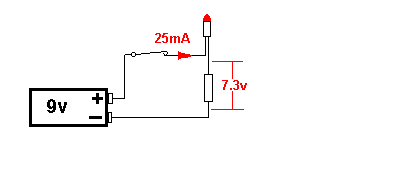
Ans: No. Resistors are made is very
large batches and their value cannot be made absolutely accurately. For
this reason they are measured and put into a "batch value." Typical
batch values are 100 ohms, 120 ohms, 150 ohms, 180 ohms, 220 ohms, 270 ohms, 330
ohms 390 ohms and higher (as well as lower), where resistors of 90 ohms to 110
ohms are put into the 100 ohm "batch," and resistors of 111 ohm
to about 135 ohms are put in the 120 ohm batch. This way all the resistors are
put into a "batch" and nothing is wasted.
Ans: The current
limiting resistor works out to
be 292 ohms but a resistor of this value is not available, so the solution is to
use the next higher or lower value - 270 ohms or 330 ohms.
Ans: Yes. Any value of resistance
can be
obtained by combining resistors in parallel and/or series.

![]()
